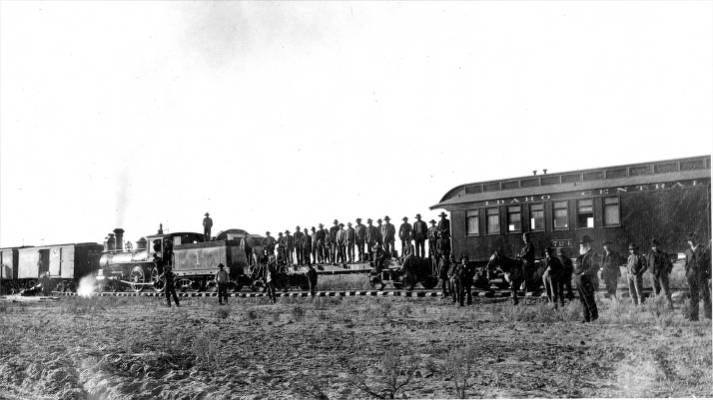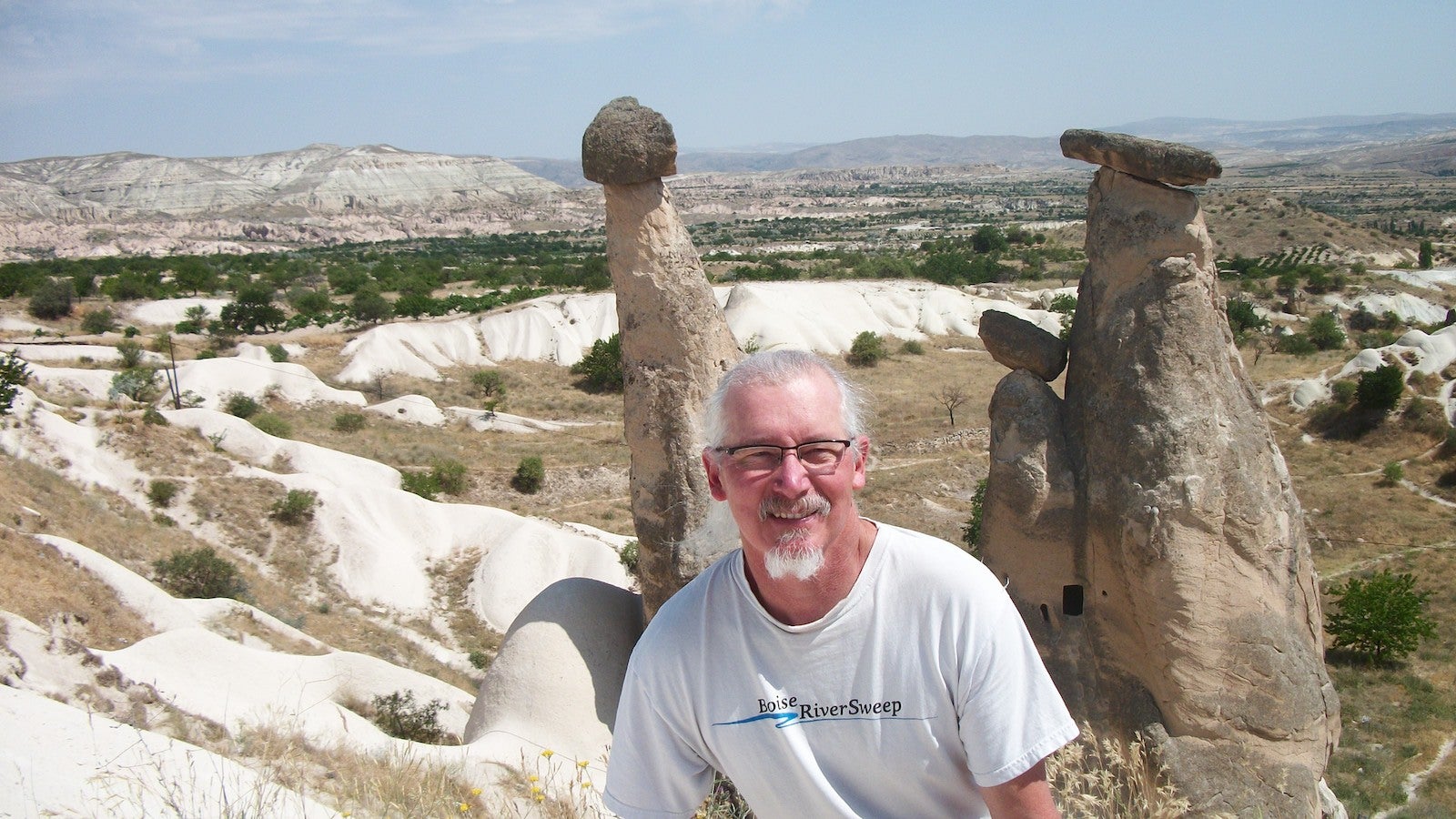
Imagine this: it’s 1869, and you are aboard a cattle car on the newly completed Transcontinental Railroad. The steers and sheep in your car jostle and munch placidly on feed from your East Coast station. As the train makes stops across the country, you sweep the trampled bedding, grasses, hay, seed and manure out of the car and into a smelly heap beside the tracks before completing the next leg of the long journey. You don’t know it yet, but you’ve become one of many vectors for the insatiable spread of cheatgrass that will plague the Western U.S. for future generations.
In 2025, cheatgrass (Bromus tectorum) is infamous for choking out native species, creating an ecological nightmare for wildlife and land managers alike and forever altering the western rangeland wildfire regime. Because of the fuel provided by cheatgrass and other invasive plants, range fires are now larger and more intense compared to those that occurred in these habitats prior to European settlement.

But where did this weed come from, how did it spread so wildly and what is being done to control it?
To begin answering these questions, we need to talk to Stephen Novak, a Boise State University biology professor who began studying the invasive weed as a doctoral student at Washington State University in the 1980s and doesn’t intend to stop anytime soon.
Where is the plant from and how did it get here?

Novak said Bromus tectorum is a Eurasian plant, and its native range spans much of Europe, northern Africa, and southwest Asia, with small outlier populations extending into Central Asia.
The first report of the plant in the U.S. was in 1790, in Lancaster County, Pennsylvania. Unfortunately, the herbarium specimen for that case was lost to time, and the earliest conclusive herbarium specimen from eastern North America is from 1859.
According to Novak, the plant spread to the U.S. with European immigrants accidentally, most likely through a combination of sources, such as livestock feed contaminant, agriculture seed contaminant, and by clinging to clothing or livestock fur. Once brought to U.S. soil, it continued to spread in ways similar to the opening scenario: accidentally, and with awful consequences.
In the eastern U.S., the unintended spread of cheatgrass in the early 1800s was facilitated by the system of canals used to transport goods. For the western U.S., railroads were a primary means of accidental transportation beginning in the late 1800s.
How did it get the name ‘cheatgrass’?
“Ostensibly, unscrupulous grain merchants would sell you a 50-pound bag of wheat seed. But they might take out about five or 10 pounds of wheat seed and put in cheatgrass seed,” Novak said. “Those two grasses look almost identical, and it’s only when they reproduce that you can see the difference. Then you realize ‘Oh my God, some of those plants in my field are not wheat! I’ve been cheated!’”
What are the economic impacts of cheatgrass and other invasives in Idaho?
“They’re tremendous,” Novak said.
Cheatgrass impacts multiple economic drivers for Idaho, such as: contaminating seed or lowering the yield of agriculture crops; requiring expensive herbicide application to keep the grass in check; harming livestock that eat the plant too late in its lifecycle. These are just a small sample of the costs Idahoans pay each year due to cheatgrass.
Now, add in the costs of wildfires caused by cheatgrass.

“Cheatgrass, wiregrass and medusahead; they all contribute to the fuel that leads to these fires, as well as other invasive plants, like tumble mustard,” Novak said. “Fighting these fires, the destruction associated with these fires in terms of loss of homes, property, lives and then the amount of money spent fighting them. Add to this, the amount of money spent trying to rehab or restore native vegetation after a fire. The costs of invasive plants…it’s enormous.”
Is there anything redemptive about cheatgrass?
According to Novak, the one positive of cheatgrass is that ranchers in the Intermountain West find early spring cheatgrass to be good forage for their livestock.
However, the window in which the grass is soft, green and easily digestible only lasts for several months. As the grass matures, it becomes problematic if eaten by livestock.
“If cows eat it too late–after it has produced seeds–they get puncture wounds in their mouths and in their stomachs, and they’ve been known to die of ulceration of these wounds,” Novak said. “Once the seeds harden up, then it’s a big problem, and you have to get the cattle off of cheatgrass-infested fields.”
Genetics and evolution of cheatgrass

For Novak, the real intrigue of cheatgrass lies in studying the genetic and evolutionary consequences of this invasive species. Uncovering the basic science behind cheatgrass could then, hopefully, be used to challenge the plant’s future spread.
“In terms of basic science, some of the genetic analysis just helps better understand the invasion process for cheatgrass. One of the interesting questions in terms of evolution is a thing called founder effects. That’s when individuals are moved, by various human activities, from one area to another and they establish a new population. [We ask] ‘Is there a loss or change in the genetic diversity of these new populations when that happens?’ So part of what my lab does is use genetic markers to determine the degree to which founder effects have occurred in invasive populations of cheatgrass,” Novak said.
Despite the fact that the plants have very similar genotypes (or genetic makeup), Novak described them as having an incredible ability to possess a range of traits across different environments in order to survive and reproduce (this is known as phenotypic plasticity). It’s why they are able to create permanent populations in every U.S. state, with the exception of Florida.
“It’s a crazy plant because it has relatively low genetic diversity and yet, it is so successful, which some people describe as the ‘genetic paradox’ of invasions.”
Fighting cheatgrass spread

*Note: the photo on the right has been color-edited for ease of viewing.
Typically, cheatgrass is battled with herbicides. The ecological issues and expense of buying and applying herbicides necessitate a better way to fight cheatgrass on a much grander, landscape-level scale.
Novak advocates for finding a successful biological control agent, or natural enemy, to defeat cheatgrass. In the perfect scenario, the agent will specifically eat or weaken the desired host plant without harming other nearby plants.
“Classic biological control is effective because you release something, it finds the target, it eats it or somehow damages it, and then the agent will move to the next plant, or the next population,” Novak said. “For example, prickly pear cactuses were incredibly destructive and invasive in Hawaii, and they found a biological control agent–a moth–in which its larvae chew into the pads of the cactus. Then opportunistic fungi and other pathogens colonize these wounds and end up killing the plant.”
In the case of cheatgrass, perhaps the perfect biological control will be an insect, fungus or a pathogen? Through the continued study of the plant’s genetic makeup, Novak and his colleagues hope to unlock the secret of cheatgrass’s kryptonite.
For more information, contact Novak at snovak@boisestate.edu